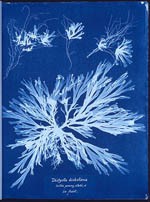"Sunny" Photograms

These days of mid-March as Spring approaches have been unusually sunny here in the Bay Area. Short sleeves. Sunglasses. Sunscreen. The quest for a bit of shade.
The rain and fog may be just around the corner, but a sunny afternoon is a great time to explore the colorful composition of light, the filtering properties of various colors, and a light-activated chemical reaction--all while making cool photographic prints without the use of a camera.
The process of "sun printing" involves using special light-sensitive paper. You place an object on the page to "block" the sunlight. After a few minutes, you remove the object and rinse the paper. The negative space (which had been exposed directly to sunlight) will show up blue. (It's not just any blue, either. It's Prussian Blue, or ferric ferrocyanide, a permanent shade of blue dye created as a result of a chemical reaction between sunlight and the special paper.) In sharp contrast to the appearance of the blue, the positive space will show up in white, x-ray style in appearance. How bright the image is depends on what you use to block the light and what color you use to block the light.
What you end up with is a photogram, a photograph created through the use of paper and light. In 1843, Anna Atkins released portions of British Algae: Cyanotype Impressions, the first book illustrated with photographs. Atkins' botanical images, like the one shown above, were all created as cyanotype photograms.
The great thing about sun printing is that is offers a wonderful chemistry demonstration for a wide range of ages. Even the youngest of students can enjoy the "craft" of sun printing and learn a bit about the science behind the print they take home. Couple sun printing with a nature walk, and students can print leaves or flower petals. Older students can explore the effectiveness of various colors as filters, evaluate the importance of ultraviolet light in this printing process, or try one of the other variations noted in the project idea or activity:
- Make a Sunprint Using Objects from Nature!
- Colorful Chemistry Creations: Make Your Own Sun Print with Color and Sunlight!
For classes and families, this project can be a lot of fun. Plus, it combines art and science!
Categories:
You Might Also Enjoy These Related Posts:
- Plastics and Earth Day - Science Projects
- Arduino Science Projects and Physical Computing
- 10+ Robotics Projects with the BlueBot Kit
- 5 STEM Activities with Marshmallow Peeps
- March Madness Basketball Science Projects: Sports Science Experiments
- Women in STEM! More than 60 Scientists and Engineers for Women's History Month
- Explore Artificial Intelligence and Machine Learning with Student AI Projects
- 10 Reasons to Do the Rubber Band Car Engineering Challenge









